课本:第3章 MenuOS的构造 内容总结
- 计算机的“三大法宝”
- 存储程序计算机
- 函数调用堆栈
- 中断
- 操作系统的“两把宝剑”
- 中断上下文切换:保存现场和恢复现场
- 进程上下文切换
在接触linux内核源代码时,linux是基于一个稳定版的内核Linux-3.18.6。其内核源码的目录结构如下:
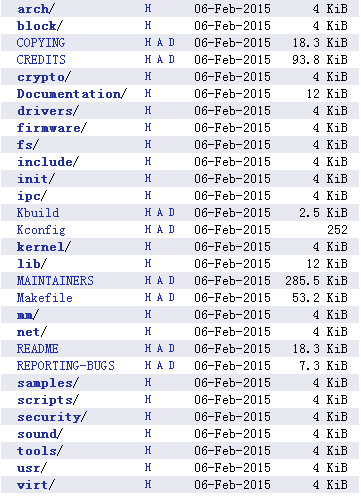
其中,arch目录是与体系结构相关的子目录列表,里面存放了许多CPU体系结构的相关代码。arch目录中的代码在linux内核代码中占比相当庞大,主要是因为arch目录中的代码可以使linux内核支持不同的CPU和体系结构。本课程实验是基于x86构架,所以只需要关心x86目录下的内容。
除了arch目录以外,还有如下几个关键目录:
- block:存放linux存储体系中关于块设备管理的代码。
- crypto:存放常见的加密算法的C语言代码。
- Documentation:存放一些文档。
- drivers:驱动目录,里面分门别类地存放了linux内核支持的所有硬件设备的驱动源代码。
- firmware:固件。
- fs:即file system(文件系统),里面列出了linux支持的各种文件系统的实现。
- include:头文件目录,存放公共头文件。
- init:初始化,存放linux内核启动时的初始化代码,其中main.c文件就在这个目录下,这是整个linux内核启动的起点,main.c中的start_kernel函数是初始化linux内核启动的起点。
- ipc:即inter-process communication(进程间通信),其目录下为linux支持的IPC代码实现。
- kernel:即linux内核,这个文件夹下存放着内核本身需要的一些核心代码文件。
- lib:共用的库文件,里面是一些公用的库函数。在内核编程中不能使用C语言的标准库函数,这里的lib目录下的库函数就是来替代那些标准库函数的。
- mm:即memory management(内存管理),存放linux的内存管理代码。
- net:该目录下是网络相关的代码,例如TCP/IP协议栈等。
- 此外还有一些与声音、安全、脚本、工具相关的目录
了解了内核的基本结构和基本功能,为下面的实验进行打下了基础和铺垫。
实验:跟踪分析Linux内核的启动过程
使用实验楼的shell环境,其已经在虚拟机中搭建好了menuOS,所以我们通过两个简单的命令就可以把linux系统和一个简单的文件系统运行起来:
cd LinuxKernel/
qemu -kernel linux-3.18.6/arch/x86/boot/bzImage -initrd rootfs.img
其中,qemu仿真kernel;bzImage是vmLinux经过gzip压缩后的文件;vmLinux是编译出来的最原始的内核ELF文件;initrd是“initial ramdisk”的缩写,是用来初始化内存根文件系统。根文件系统一般包括内存根文件系统和磁盘文件系统,普通linux用户一般感受不到这个内存根文件系统的存在,因为在普通linux系统在启动时,是boot loader将存储介质中的initrd文件加载到内存,内核启动时先访问initrd文件系统,然后再切换到磁盘文件系统。本次实验简化为只使用了initrd根文件系统,创建了一个rootfs.img,其中只有一个init功能,用menu程序替代init。内核启动完成后进入menu程序。效果如下图所示:
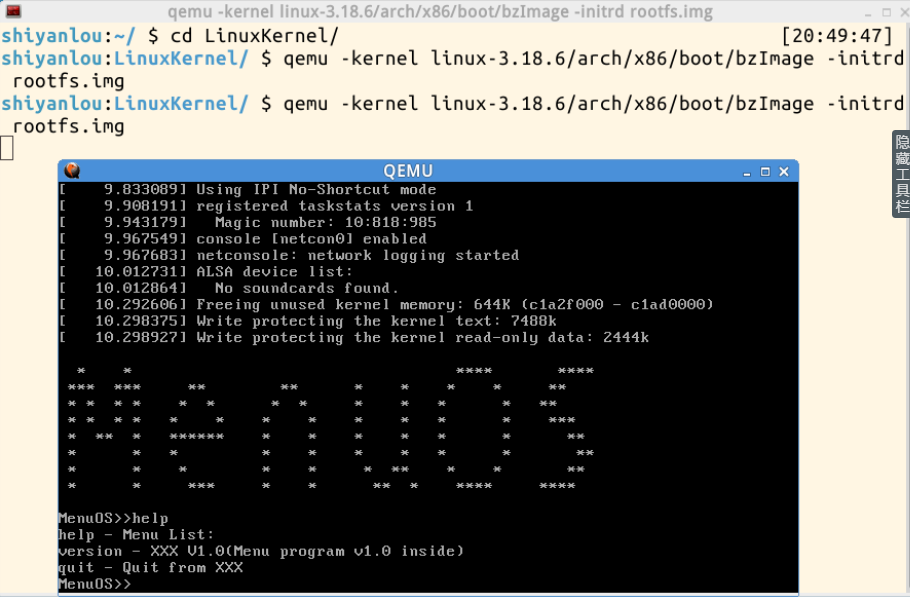
可以看到,menu项目支持3个命令:help、version和quit。
下面,使用gdb跟踪调试内核,输入以下命令:
qemu -kernel linux-3.18.6/arch/x86/boot/bzImage -initrd rootfs.img -s -S # 关于-s和-S选项的说明:
-S freeze CPU at startup (use ’c’ to start execution)
-s shorthand for -gdb tcp::1234 若不想使用1234端口,则可以使用-gdb tcp:xxxx来取代-s选项
效果如下:

水平分割窗口,启动gdb,输入以下命令:
gdb
(gdb)file linux-3.18.6/vmlinux # 在gdb界面中targe remote之前加载符号表
(gdb)target remote:1234 # 建立gdb和gdbserver之间的连接,按c 让qemu上的Linux继续运行
(gdb)break start_kernel # 断点的设置可以在target remote之前,也可以在之后
执行效果如下:
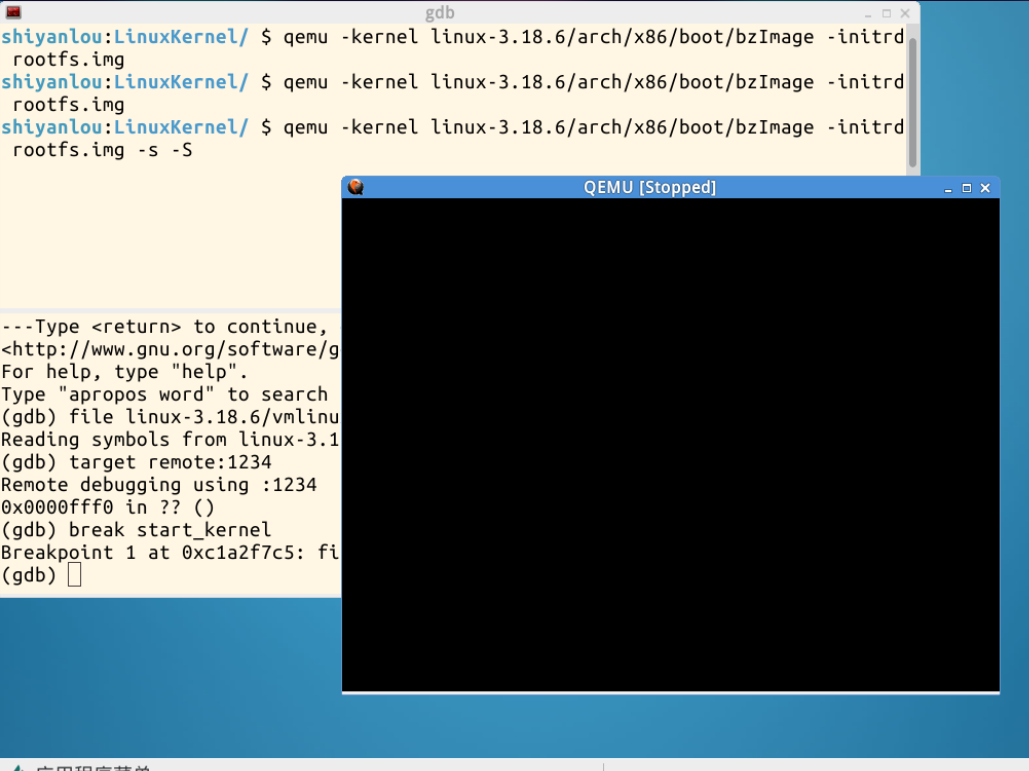
在start_kernel处设置了断点,使用continue命令让程序执行到断点位置,如下图所示:
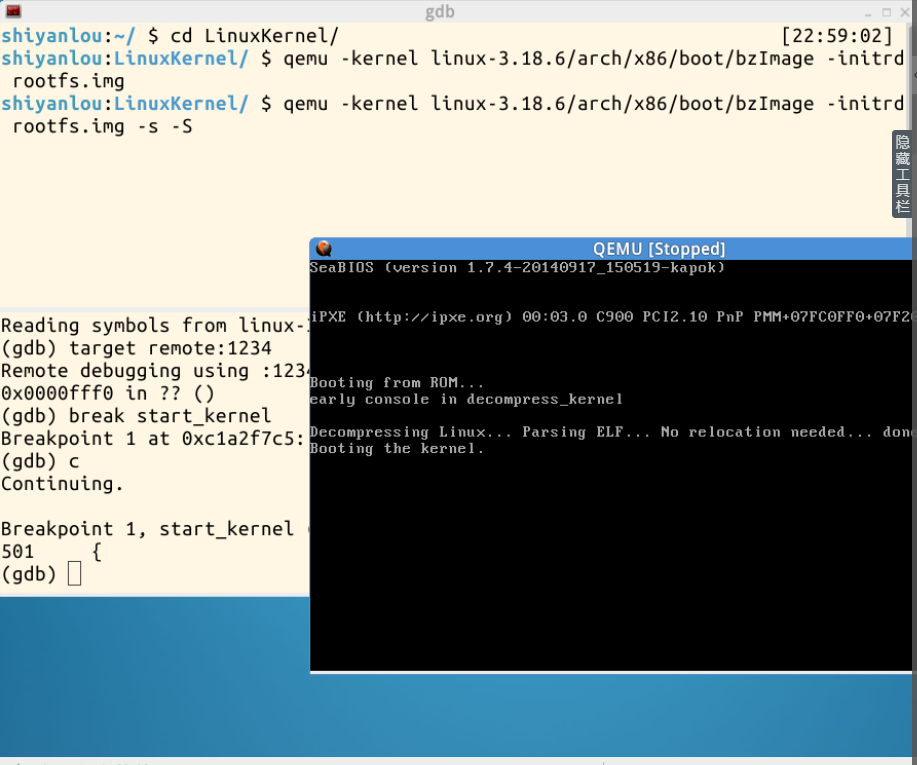
可以看到在程序执行到start_kernel断点处,qemu窗口中的执行效果。下面再在rest_init处为内核代码增加一个断点,执行效果如下:
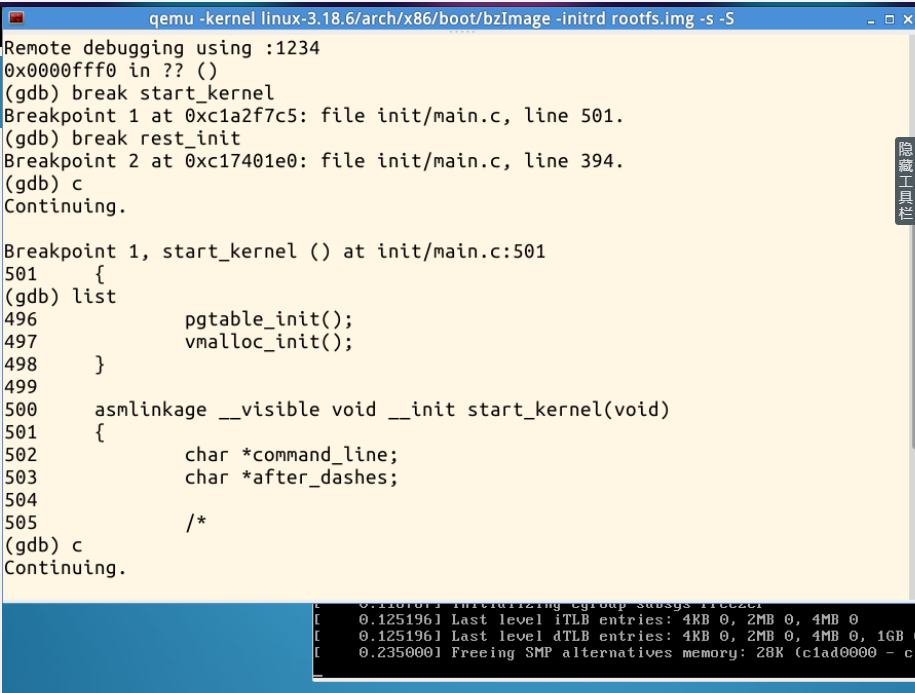
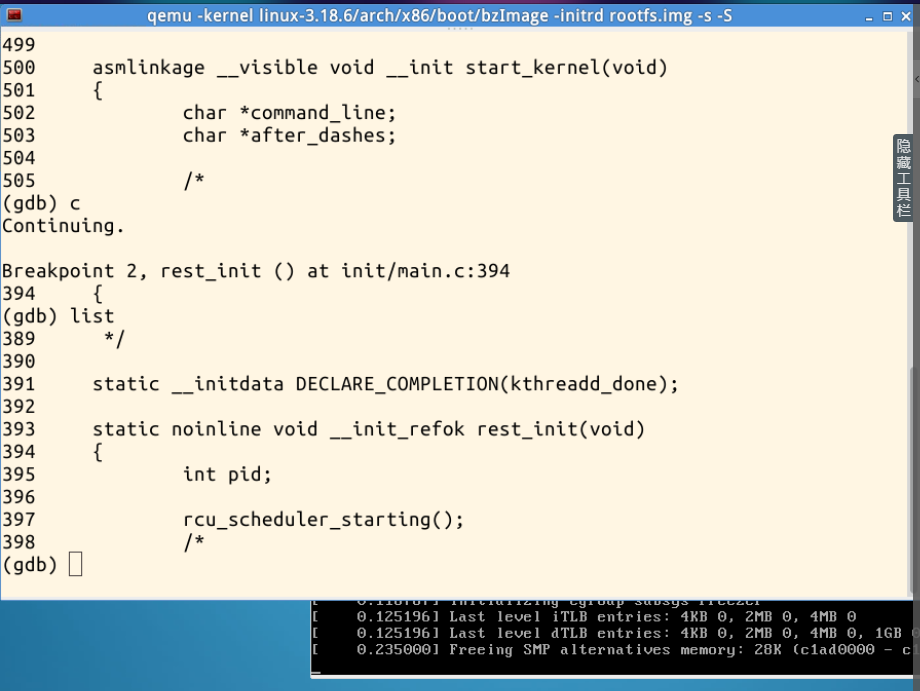
代码分析
start_kernel()函数
asmlinkage __visible void __init start_kernel(void)
{
char *command_line;
char *after_dashes;
lockdep_init();
set_task_stack_end_magic(&init_task);
smp_setup_processor_id();
debug_objects_early_init();
boot_init_stack_canary();
cgroup_init_early();
local_irq_disable();
early_boot_irqs_disabled = true;
/*
* Interrupts are still disabled. Do necessary setups, then
* enable them
*/
boot_cpu_init();
page_address_init();
pr_notice("%s", linux_banner);
setup_arch(&command_line);
mm_init_cpumask(&init_mm);
setup_command_line(command_line);
setup_nr_cpu_ids();
setup_per_cpu_areas();
smp_prepare_boot_cpu(); /* arch-specific boot-cpu hooks */
build_all_zonelists(NULL, NULL);
page_alloc_init();
pr_notice("Kernel command line: %s
", boot_command_line);
parse_early_param();
after_dashes = parse_args("Booting kernel",
static_command_line, __start___param,
__stop___param - __start___param,
-1, -1, &unknown_bootoption);
if (!IS_ERR_OR_NULL(after_dashes))
parse_args("Setting init args", after_dashes, NULL, 0, -1, -1,
set_init_arg);
jump_label_init();
/*
* These use large bootmem allocations and must precede
* kmem_cache_init()
*/
setup_log_buf(0);
pidhash_init();
vfs_caches_init_early();
sort_main_extable();
trap_init();
mm_init();
/*
* Set up the scheduler prior starting any interrupts (such as the
* timer interrupt). Full topology setup happens at smp_init()
* time - but meanwhile we still have a functioning scheduler.
*/
sched_init();
* Disable preemption - early bootup scheduling is extremely
* fragile until we cpu_idle() for the first time.
*/
preempt_disable();
if (WARN(!irqs_disabled(),
"Interrupts were enabled *very* early, fixing it
"))
local_irq_disable();
idr_init_cache();
rcu_init();
context_tracking_init();
radix_tree_init();
/*
init some links before init_ISA_irqs()
*/
early_irq_init();
init_IRQ();
tick_init();
rcu_init_nohz();
init_timers();
hrtimers_init();
softirq_init();
timekeeping_init();
time_init();
sched_clock_postinit();
perf_event_init();
profile_init();
call_function_init();
WARN(!irqs_disabled(), "Interrupts were enabled early
");
early_boot_irqs_disabled = false;
local_irq_enable();
kmem_cache_init_late();
/*
* HACK ALERT! This is early. We're enabling the console before
* we've done PCI setups etc, and console_init() must be aware of
* this. But we do want output early, in case something goes wrong.
*/
console_init();
if (panic_later)
panic("Too many boot %s vars at `%s'", panic_later,
panic_param);
lockdep_info();
/*
* Need to run this when irqs are enabled, because it wants
* to self-test [hard/soft]-irqs on/off lock inversion bugs
* too:
*/
locking_selftest();
#ifdef CONFIG_BLK_DEV_INITRD
if (initrd_start && !initrd_below_start_ok &&
page_to_pfn(virt_to_page((void *)initrd_start)) < min_low_pfn) {
pr_crit("initrd overwritten (0x%08lx < 0x%08lx) - disabling it.
",
page_to_pfn(virt_to_page((void *)initrd_start)),
min_low_pfn);
initrd_start = 0;
}
#endif
page_cgroup_init();
debug_objects_mem_init();
kmemleak_init();
setup_per_cpu_pageset();
numa_policy_init();
if (late_time_init)
late_time_init();
sched_clock_init();
calibrate_delay();
pidmap_init();
anon_vma_init();
acpi_early_init();
#ifdef CONFIG_X86 /*与x86硬件相关代码 如果主板支持EFI的话*/
if (efi_enabled(EFI_RUNTIME_SERVICES))
efi_enter_virtual_mode();
#endif
#ifdef CONFIG_X86_ESPFIX64
/* Should be run before the first non-init thread is created */
init_espfix_bsp();
#endif
thread_info_cache_init();
cred_init();
fork_init(totalram_pages);
proc_caches_init();
buffer_init();
key_init();
security_init();
dbg_late_init();
vfs_caches_init(totalram_pages);
signals_init();
/* rootfs populating might need page-writeback */
page_writeback_init();
proc_root_init();
cgroup_init();
cpuset_init();
taskstats_init_early();
delayacct_init();
check_bugs();
sfi_init_late();
if (efi_enabled(EFI_RUNTIME_SERVICES)) {
efi_late_init();
efi_free_boot_services();
}
ftrace_init();
/* Do the rest non-__init'ed, we're now alive */
rest_init();
}
start_kernel()函数分析
start_kernel()函数的作用是内核中各种模块的初始化。其中,start_kernel()函数中set_task_stack_end_magic(&init_task)中的init_task即初始化手工创建的PCB,0号进程即最终的idle进程,idle进程由系统自动创建, 运行在内核态。当系统没有需要执行的进程时就调度到idle进程。
rest_init()函数
static noinline void __init_refok rest_init(void)
{
int pid;
rcu_scheduler_starting();
/*
* We need to spawn init first so that it obtains pid 1, however
* the init task will end up wanting to create kthreads, which, if
* we schedule it before we create kthreadd, will OOPS.
*/
kernel_thread(kernel_init, NULL, CLONE_FS);
numa_default_policy();
pid = kernel_thread(kthreadd, NULL, CLONE_FS | CLONE_FILES);
rcu_read_lock();
kthreadd_task = find_task_by_pid_ns(pid, &init_pid_ns);
rcu_read_unlock();
complete(&kthreadd_done);
/*
* The boot idle thread must execute schedule()
* at least once to get things moving:
*/
init_idle_bootup_task(current); /*idle初始化*/
schedule_preempt_disabled();
/* Call into cpu_idle with preempt disabled */
cpu_startup_entry(CPUHP_ONLINE);
}
rest_init()函数分析
通过rest_init()函数新建kernel_init和kthreadd进程,分别为系统的1号进程和2号进程。系统的进程创建遵从“道生一,一生二,二生三,三生万物”的思想,0号进程创建1号进程,创建2号进程,以此类推,层层推进。
总结
start_kernel()函数为内核启动的起点,执行了各种初始化操作,对于本次实验的进行来说,除了实验楼的虚拟机环境偶尔出现了一些小问题,其他方面实验进行的还是比较顺利的,没有遇到什么问题。但是对于内核启动过程的理解还是比较困难的,start_kernel()的各个模块做了非常繁杂的初始化操作,内核得以正常启动。
本次实验结合《庖丁解牛》和对应的实验楼实验以及视频教程配合完成,对于linux内核源码文件的目录结构、作用以及内核启动及初始化的过程有了一个初步的整体了解,但对于其细致的过程还不太明白,内核的启动过程十分复杂。希望在今后的实验过程中,通过一系列实验,对linux内核的工作慢慢有更深一步的认识和理解。
因为本次实验过程中自己电脑的linux虚拟环境出现了一些问题不能正常启动,所以此次实验完全在已经配置好了的实验楼环境中进行,在后面会在自己电脑的环境中再完整的配置一遍内核的启动过程。